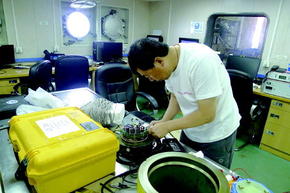Behind Xuelong's 160-day expedition
china.org.cn / chinagate.cn by Yan Pei, May 19, 2014 Adjust font size:
During its 160-day expedition, Xuelong has pulled itself through several obstacles, including rescuing a Russian ship, escaping from heavy sea ice and searching for missing flight MH370.
 |
|
Jiao Yutian. |
Jiao Yutian on May 6 finally returned to China's Qingdao in Shandong Province, after a 160-day voyage on the icebreaker Xuelong across the Antarctic. During the 160 days, Xuelong has pulled itself through several rough situations, including rescuing a Russian scientific mission ship, escaping heavy sea ice and searching for the missing Malaysia Airlines flight MH370. The trip awarded the 54-year-old senior engineer from the Ocean University of China his most impressive experience on the icy continent thus far.
Rescuing the Russian ship
On Christmas Eve 2013, the Russian ship MV AkademikShokalskiy got stuck 2700 kilometers south of Hobart, Australia.
According to Jiao, at that time, Xuelong was the nearest vessel to the stranded Russian ship when it was making its way to the Ross Sea after leaving Zhongshan Station.
After receiving the signal for help, "we arrived in an area of floating ice near the trapped Russian ship that was just 6 nautical miles away from the rescue," said Jiao. "However, the ice was too thick and Xuelong was stuck. We had no other choice, but to dispatch a helicopter to transfer the trapped passengers."
To make matters worse, the Russian ship could not accommodate the landing of the 17-ton Xueying helicopter. Landing Xueying on floating ice became the key to a successful rescue. After intensive discussions, exploration team members decided to lay wooden boards across the floating ice to serve as a parking apron.
Jiao and his crew members on Jan. 2, 2014, set out from Xuelong onto Xueying, carrying 20 wooden boards. Every time Xueying managed to locate a suitable block of floating ice, Jiao and his team members would jump off the helicopter to measure the thickness of the ice.
"We jumped onto the ice blocks without any hesitation. But you know, sometimes the deep sea waters will hide just below the floating ice," said Jiao.
After measuring the ice blocks, members would use shovels to flatten their surface and lay wooden boards on top for the helicopter to land.
The Australian icebreaker Aurora Australis, waiting to receive the stranded team members, could not board the Xueying helicopter either, continued Jiao. As a result, Jiao and his team members again used the same methods and safely landed the rescued members onto floating ice near the Aurora Australis.
Surprisingly, after successfully rescuing the Russian ship, Xuelong itself got trapped by ice floes on Jan. 3 and did not manage a successful escape until Jan. 7.


